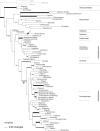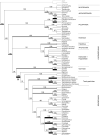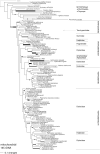Monophyly of terrestrial adephagan beetles as indicated by three nuclear genes (Coleoptera: Carabidae and Trachypachidae)
- PMID: 19789725
- PMCID: PMC2752903
- DOI: 10.1111/j.1463-6409.2008.00359.x
Monophyly of terrestrial adephagan beetles as indicated by three nuclear genes (Coleoptera: Carabidae and Trachypachidae)
Abstract
The beetle suborder Adephaga is traditionally divided into two sections on the basis of habitat, terrestrial Geadephaga and aquatic Hydradephaga. Monophyly of both groups is uncertain, and the relationship of the two groups has implications for inferring habitat transitions within Adephaga. Here we examine phylogenetic relationships of these groups using evidence provided by DNA sequences from all four suborders of beetles, including 60 species of Adephaga, four Archostemata, three Myxophaga, and ten Polyphaga. We studied 18S ribosomal DNA and 28S ribosomal DNA, aligned with consideration of secondary structure, as well as the nuclear protein-coding gene wingless. Independent and combined Bayesian, likelihood, and parsimony analyses of all three genes supported placement of Trachypachidae in a monophyletic Geadephaga, although for analyses of 28S rDNA and some parsimony analyses only if Coleoptera is constrained to be monophyletic. Most analyses showed limited support for the monophyly of Hydradephaga. Outside of Adephaga, there is support from the ribosomal genes for a sister group relationship between Adephaga and Polyphaga. Within the small number of sampled Polyphaga, analyses of 18S rDNA, wingless, and the combined matrix supports monophyly of Polyphaga exclusive of Scirtoidea. Unconstrained analyses of the evolution of habitat suggest that Adephaga was ancestrally aquatic with one transition to terrestrial. However, in analyses constrained to disallow changes from aquatic to terrestrial habitat, the phylogenies imply two origins of aquatic habit within Adephaga.
Figures








References
-
- Abascal F, Zardoya R, Posada D. ProtTest: Selection of best-fit models of protein evolution. Bioinformatics. 2005;21:2104–2105. - PubMed
-
- Alarie Y, Bilton DT. Larval morphology of Aspidytidae (Coleoptera: Adephaga) and its phylogenetic implications. Annals of the Entomological Society of America. 2005;98:417–430.
-
- Alarie Y, Michat MC. Primary setae and pores on the maxilla of larvae of the subfamily Hydroporinae (Coleoptera: Adephaga: Dytiscidae): Ground plan pattern reconsidered. The Coleopterists Bulletin. 2007;61:310–317.
-
- Alverson AJ, Cannone JJ, Gutell RR, Theriot EC. The evolution of elongate shape in diatoms. Journal of Phycology. 2006;42:655–668.
-
- Arndt E. Carabid larvae (Coleoptera, Carabidae) as subject of phylogenetical research. Entomologische Nachrichten und Berichte. 1989;33:255–260.
Grants and funding
LinkOut - more resources
Full Text Sources
Molecular Biology Databases
